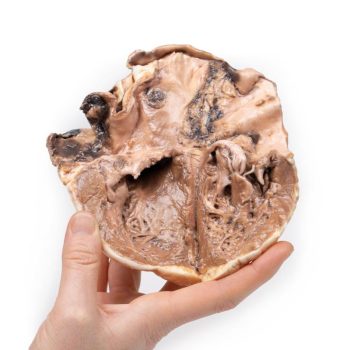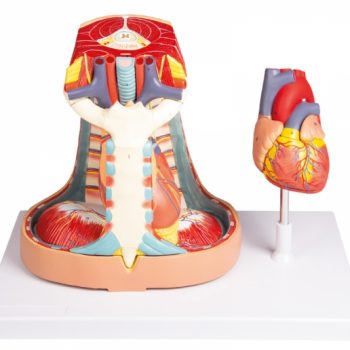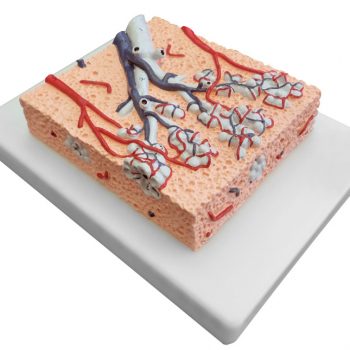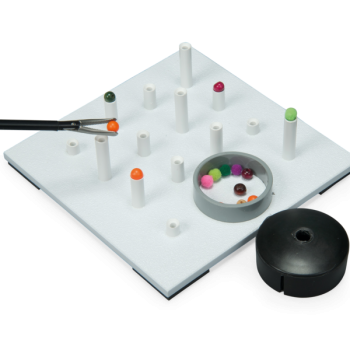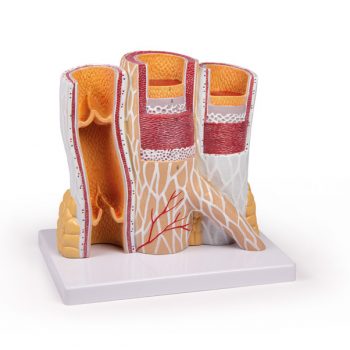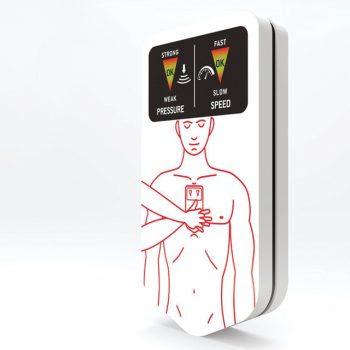Product information “Rheumatic endocarditis”
Clinical History
The patient was a 52-year old female with increasing dyspnoea. She gave a past history of fever with flitting joint pains in childhood following a sore throat. On examination: cyanotic, pulse showed atrial fibrillation, jugular venous pulse elevated, pan-systolic murmur at apex, hepatomegaly, and dependent oedema. She was being treated with digoxin, lasix (furosemide) and penicillin but died after cardiac arrest.
Pathology
The specimen is that of a heart opened to show the left atrium and left ventricle. The mitral valve has been cut, but those visible parts show significant thickening. The left atrial wall shows deposition of blood and fibrin. The left auricular appendage is filled with blood clot, caused by atrial fibrillation. The mural thrombus on the atrial wall is in the typical site:- the deep layers of the endocardium forming irregular thickenings, called MacCallum’s plaques (arrows).
Further Information
In this patient, the history of fever and joint pains following a sore throat is very suggestive of a history of rheumatic fever. Rheumatic fever is an inflammatory disease that can involve the heart, joints, skin, and brain. Typical symptoms include fever, multiple painful joints, involuntary muscle movements (chorea), and occasionally a characteristic non-itchy rash known as ‘erythema marginatum’.
Rheumatic fever may occur 2-4 weeks following an infection of the throat by the bacterium Streptococcus pyogenes. If the infection is left untreated (with pencillin), rheumatic fever occurs in up to three percent of people. The underlying mechanism is believed to involve the production of antibodies against a person‘s own tissues (autoimmune disease). Due to their genetics, some people are more likely to get the disease when exposed to the bacteria than others. Other risk factors include malnutrition and poverty, occurring more commonly in low to middle income countries and particularly in Indigenous communities.
The heart is involved in about half of the cases. Damage to the heart valves, known as rheumatic heart disease (RHD), usually occurs after repeated attacks (carditis) but can sometimes occur after one. Carditis can progress to chronic rheumatic heart disease, usually affecting cardiac valves. The mitral valve is the most commonly affected valve, with fibrosis leading to mitral valve stenosis and this specimen highlights the thickening of the mitral valve. Stenosis is thought to occur due to Aschoff nodules, which are granulomatous lesions with a central area of fibrinoid necrosis and surrounded by an infiltration of autoreactive T cells. The Aschoff nodules also contain ‘giant cells’, which are thought to be some type of degenerative connective or endothelial tissue.
Stenosis may progress through the years and as it worsens, the left atrium will become increasingly dilated. Consequentially, atrial fibrillation may develop and mural thrombi can be formed. Further, tight mitral stenosis can result in severe cardiac failure.


